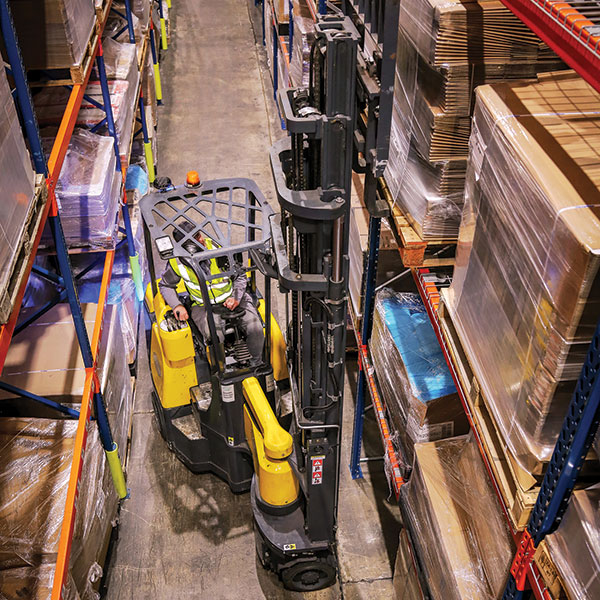The move to narrow aisle warehouse aisle configuration
Warehouse space costs have skyrocketed, so more companies want to maximize existing space by moving to narrow aisle configurations. However, making that transition effectively can benefit from some layout and material flow expertise, not just choosing appropriate equipment.
Getting more pallets out the door in the same amount space has always been a good idea, but recent trends make this goal cost imperative.
According to research from CBRE released last December, companies that struck five-year leases back in 2016 were facing net increases of 25% on new occupancy deals in 2021. In some regions, the increases are steeper—enough for CBRE to call it a “sticker shock” development.
This trend reverberates down to the trusty lift truck, and not only that, the need for help in adopting narrow aisle layouts. Paul Short, president, North America, for Combilift, says the narrow aisle trend not only has increased interest in Combilift’s narrow aisle trucks, but in its free layout and design services.
“Adding warehouse space right now is just very cost prohibitive, so companies want to optimize the space they have,” says Short. “Many companies also must increase output for reasons like growth, or to dedicate more space to activities like manufacturing, so if they can be more space efficient with their existing building, it’s just very, very attractive to them.”
Various lift truck types suit narrow aisles. Options include articulating trucks, wire-guided turret trucks, and other types. But a narrow aisle migration also calls for careful thinking about layout, and the material flow to meet expected throughput.
Short’s advice: Get expert advice on layout and material flow. Many of Combilift’s customers have gained significant space, Short explains, by moving from 10-foot or 11-foot aisle widths down to aisles of between 78 to 84 inches in width (6.5 to 7 feet), using articulating trucks like Combilift’s Aisle Master lineup, which can also operate in wider aisles.
Combilift’s design team will study the number of pallets or trailer loads that need to be shipped out of a facility per day or shift, as well as the inbound flow, and use those numbers as a starting point for devising a narrow aisle layout. The service also includes an assessment of material flow, looking at the makeup of fast movers, medium movers, and slower moving goods in a building, complete with a CAD drawing of the layout and calculations on material flow.
“It’s absolutely essential that you’re taking a wholistic view of not just the method of devising a new layout, but how your materials will actually flow through the building with that new configuration,” says Short. “It’s about optimizing flow and storage within narrow aisles, not just the narrow aisle set up.”
The actual transition to narrow aisle can be phased in a couple of aisles at a time, Short says, typically starting with slow movers. Existing rack can often be repositioned to a denser configuration, with some new rack added if the goal is to gain storage, versus freeing up space for other activities like manufacturing or value-added services.
“The first couple aisles are the most challenging, because you have to find a location to put goods temporarily, but these transitions aren’t difficult with a good plan,” Short says. “Some companies will phase it in on weekends to minimize disruption.”
Aurora Parts, a Lebanon, Ind.-based national provider of heavy-duty trailer parts and equipment, has tapped Combilift’s expertise in narrow aisle. Brad Fulkerson, Aurora Parts’ president and CEO, says what initially drew Aurora’s interest in Combilift was its long-load handling trucks, because many of the trailer body and floor parts Aurora offers are 53-feet long. It has other parts it stores on cantilever rack, such as truck axles, along with more conventionally sized goods on pallets.
As it looked to expand its DC network to improve customer service, Aurora wanted to be highly space efficient, so it ended up not just sourcing trucks from Combilift, but also turning to it for layout and material flow help.
“The new equipment, but also the collaboration between our engineers and their engineers, helped us get a lot of product into the available cube for our DCs as we expanded our network,” says Fulkerson. “The work resulted in a lot more storage than we initially thought we could get out of the buildings. We’ve used those ideas as sort of a template, which we continue to refine, as the way to do narrow aisle.”

Article Topics
Narrow Aisle News & Resources
NA and VNA trucks: Jumping on the narrow aisle trend Simple, smarter moves for narrow aisle storage and order picking The move to narrow aisle warehouse aisle configuration Lift Truck Tips: Go narrow but keep the comfort Lift Truck Series: Narrow aisle trucks on the rise Goya Foods’ modified trucks enhance facility’s throughput A sweet storage solution More Narrow AisleLatest in Materials Handling
Geek+ and System Teknik deploy PopPick solution for pharmacy group Med24.dk Beckhoff USA opens new office in Austin, Texas Manhattan Associates selects TeamViewer as partner for warehouse vision picking ASME Foundation wins grant for technical workforce development The (Not So) Secret Weapons: How Key Cabinets and Asset Management Lockers Are Changing Supply Chain Operations MODEX C-Suite Interview with Harold Vanasse: The perfect blend of automation and sustainability Consultant and industry leader John M. Hill passes on at age 86 More Materials HandlingAbout the Author
Subscribe to Materials Handling Magazine

Find out what the world's most innovative companies are doing to improve productivity in their plants and distribution centers.
Start your FREE subscription today.
April 2024 Modern Materials Handling

Latest Resources












